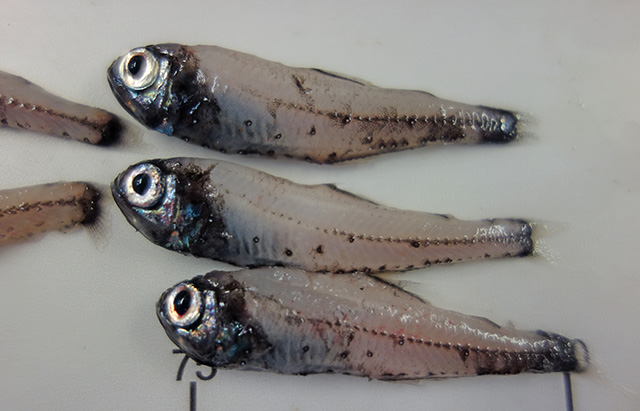Benthosema
glaciale
(Reinhardt,
1837)
Glacier lantern fish
View all media / Upload your photos and videos
Expand all
Classification / Names
Teleostei (teleosts) > Myctophiformes (Lanternfishes) >
Myctophidae (Lanternfishes)
> Myctophinae
Etymology: Benthosema: Greek, benthos = depth of the sea + Greek, sema, sematos = signal, flag (Ref. 45335).
More on author:
Reinhardt.
Environment / milieu / depth range / climate zone / distribution range
Distribution
Eastern Atlantic: Norway and Greenland south to Morocco, and from Mauritania to Guinea (Mauritanian Upwelling Region). Seasonally present from Morocco to Mauritania along the edge of the continental shelf. Also known from the Mediterranean Sea. Western Atlantic: Baffin Bay to northern edge of Gulf Stream. Northwest Atlantic: Canada (Ref. 5951).
Maps

Benthosema glaciale / Native range
AquaMaps Data sources:
GBIF
OBIS
This map was computer-generated and has not yet been reviewed.

Benthosema glaciale / Suitable habitat
AquaMaps Data sources:
GBIF
OBIS
This map was computer-generated and has not yet been reviewed.

Benthosema glaciale / Point map
AquaMaps Data sources:
GBIF
OBIS
This map was computer-generated and has not yet been reviewed.

Benthosema glaciale / Year 2050
AquaMaps Data sources:
GBIF
OBIS
This map was computer-generated and has not yet been reviewed.
Length at first maturity / Size / Weight / Age
Short description
Dorsal spines (total): 0; Dorsal soft rays (total): 13 - 14; Anal soft rays: 17 - 19. Males with single black-bordered supracaudal gland; females with two infra-caudal luminous patches; occasional specimens with both. Luminous organs in the anal area, 5-6 anteriorly and 5-7 posteriorly, 11-13 total.
Biology
High-oceanic, mesopelagic at depths between 375-800 m during daytime and 12-200 m during night. Depth range from 0-850 m (Ref. 4479) and from 541-1085 m in the eastern Ionian Sea (Ref. 56504). Photophores present. Feeds mainly on calanoid copepods, also euphausiids and copepodites. Feeding occurs at night in Norwegian fjords (Ref. 9209) and in northwest Africa (Ref. 9194). Mature from about 3 cm onward. Spawning peaks in the Mediterranean in late spring with east-to-west progression. Female produces 160-2,000 eggs depending on her size (Ref. 35388).
Life cycle and mating behavior
Spawns both north and south of the Polar Fronts in the eastern North Atlantic. Reported to perish after spawning (Ref. 9707).
Main reference
Bauchot, M.-L. 1987 Poissons osseux. p. 891-1421. In W. Fischer, M.L. Bauchot and M. Schneider (eds.) Fiches FAO d'identification pour les besoins de la pêche. (rev. 1). Méditerranée et mer Noire. Zone de pêche 37. Vol. II. Commission des Communautés Européennes and FAO, Rome. (Ref. 3397)
IUCN Red List Status (Ref. 125652)
Least Concern (LC); date assessed: July 10 2012
CITES (Ref. 131153)
Not Evaluated
CMS (Ref. 116361)
Not Evaluated
Threat to humans
Harmless
More information
- Countries
- FAO areas
- Ecosystems
- Occurrences
- Introductions
- Stocks
- Ecology
- Diet
- Food items
- Food consumption
- Ration
- Common names
- Synonyms
- Metabolism
- Predators
- Ecotoxicology
- Reproduction
- Maturity
- Spawning
- Spawning aggregation
- Fecundity
- Eggs
- Egg development
- Age/Size
- Growth
- Length-weight
- Length-length
- Length-frequencies
- Morphometrics
- Morphology
- Larvae
- Larval dynamics
- Recruitment
- Abundance
- References
- Aquaculture
- Aquaculture profile
- Strains
- Genetics
- Allele frequencies
- Heritability
- Diseases
- Processing
- Mass conversion
- Vision
- Pictures
- Stamps, Coins Misc.
- Sounds
- Ciguatera
- Speed
- Swim. type
- Gill area
- Otoliths
- Brains
Estimates based on models
Preferred temperature (Ref. 123201): 1.6 - 12.8, mean 5.1 °C (based on 258 cells).
Phylogenetic diversity index (Ref. 82804): PD50 = 0.5312 [Uniqueness, from 0.5 = low to 2.0 = high].
Bayesian length-weight: a=0.00871 (0.00704 - 0.01078), b=3.09 (3.03 - 3.15), in cm total length, based on LWR estimates for this species (Ref. 93245).
Trophic level (Ref. 69278): 3.1 ±0.3 se; Based on food items.
Resilience (Ref. 120179): Medium, minimum population doubling time 1.4 - 4.4 years (K=0.20-0.45; tm=1-3; tmax=8; Fec=162).
Fishing vulnerability (Ref. 59153): Low to moderate vulnerability (27 of 100).
Price category (Ref. 80766): High; Very questionable: based on ex-vessel price for species in this family.
Nutrients (Ref. 124155): Calcium = 123 [33, 471] mg/100g; Iron = 1.07 [0.34, 3.69] mg/100g; Protein = 17.1 [14.5, 19.6] %; Omega3 = 1.11 [0.47, 2.67] g/100g; Selenium = 21.5 [5.3, 95.2] μg/100g; VitaminA = 58.7 [7.6, 434.5] μg/100g; Zinc = 0.697 [0.293, 1.744] mg/100g (wet weight);








